Beautification movement
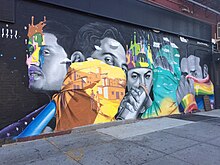
Given the various benefits and high return on investment street art provides to businesses, schools, neighborhoods, and cities, a movement of using street art as a tool to create safer, brighter, more colorful, and inspiring communities has also been recognized. Organizations like Beautify Earth have pioneered cities to leverage these benefits to create widespread beauty where it would be otherwise empty or dilapidated public wall space.
North Americaedit
New York City attracts artists from around the world. In Manhattan, "post-graffiti" street art grew in the 1980s from the then largely vacant neighborhoods of SoHo and the Lower East Side. The Chelsea art district became another locale, with area galleries also hosting formal exhibitions of street artist's work. In Brooklyn, the Williamsburg and Dumbo neighborhoods — especially near the waterfront — are recognized street art sites.
Chicago has many forms of street art emerging but some of the most popular artists that can be seen everywhere in Chicago is Sentrock, Jc Rivera (The Bear Champ), and Hebru Brantley.
Programs in the Pennsylvania cities of Philadelphia and Pittsburgh provide funding to agencies who employ street artists to decorate city walls. The Mural Arts Program established in 1984 has helped Philadelphia earn praise as the "City of Murals". The project was initiated to encourage graffiti artists toward a more constructive use of their talents. Murals backed by The Sprout Fund in Pittsburgh were named the "Best Public Art" by the Pittsburgh City Paper in 2006.
Street art in Atlanta centers on the Old Fourth Ward and Reynoldstown neighborhoods, the Krog Street Tunnel, and along the 22-mile BeltLine railway corridor which circles the inner city. Atlanta established a Graffiti Task Force in 2011. Although the city selected a number of murals that would not be targeted by the task force, the selection process overlooked street art of the popular Krug Street Tunnel site. Art created in conjunction with the Living Walls street art conference, which Atlanta hosts annually, was spared. Some actions were taken by the unit, including arrests of artists deemed vandals, caused community opposition; some considered the city's efforts as "misdirected" or "futile". After being sued by a group of artists in 2017 the city of Atlanta agreed not to enforce an ordinance requiring artists to obtain city approval for murals on private property. Images and locations of over 200 works of Atlanta street art can be found on the Atlanta Street Art Map.
Sarasota, Florida, hosts an annual street art event, the Sarasota Chalk Festival, founded in 2007. An independent offshoot known as Going Vertical sponsors works by street artists, but some have been removed as controversial.
Los Angeles's Arts District is known for its high concentration street murals. The neighborhood of Hollywood and streets such as Sunset Boulevard, La Brea, Beverly Boulevard, La Cienega, and Melrose Avenue are among other key locations. LAB ART Los Angeles, opened in 2011, devotes its 6,500 square feet of gallery space to street art. Artwork by locals such as Alec Monopoly, Annie Preece, Smear and Morley are among the collection.
San Francisco's Mission District has densely packed street art along Mission Street, and along both Clarion and Balmy Alleys. Streets of Hayes Valley, SoMa, Bayview-Hunters Point and the Tenderloin have also become known for street art. San Diego's East Village, Little Italy, North Park, and South Park neighborhoods contain street artwork of VHILS, Shepard Fairey, Tavar Zawacki a.k.a. ABOVE, Space Invader, Os Gêmeos, among others. Murals by various Mexican artists can be seen at Chicano Park in the Barrio Logan neighborhood.
Montreal (Canada) With over 80 murals and counting since the foundation of MURAL Festival in 2013, the annual street art festival contributed to creating Le Plateau-Mont-Royal as an epicenter for urban arts. Villeray, Downtown Montreal Le Sud-Ouest, Hochelaga-Maisonneuve, and multiple art districts also continue to broaden the street art circuit within the Island of Montreal.citation needed
Toronto (Canada) has a significant graffiti scene.
Calgary (Canada) While historically having a smaller graffiti street art scene, the city recently started the Beltline Urban Mural Project (BUMP) with artists from all over the world creating large murals in the city center.
Richmond, Virginia has over 100 murals created by artists, many of whom are alumni of Virginia Commonwealth University's School of the Arts or current students there. Some of the murals are privately commissioned by individuals and businesses, some are created by solo street artists, and some are collaborative group fund-raising projects.
Denver street artists have been busy brightening (and enlightening) the urban landscape for decades by making canvases of the city's alleyways, building exteriors, warehouses, garage doors and storefronts. The city of Denver has a whole area called the River North Art District (RiNo) that is dedicated to the work of local creative artists. Most artists in the RiNo district are commissioned by the local business owners who want to give their buildings colorful imagery.citation needed
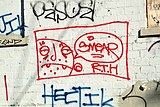
Smear, Los Angeles (2006)
Mexico
The manifestations of street art in Mexico began in the late 80s in Mexico City, inside multifamily buildings in the north of the city and also in the subway. Since then, urban art and graffiti have formed an essential part of cultural identity in the different city halls of the metropolis. Currently, some different associations and groups are dedicated to the creation and search of spaces for urban art in Mexico City and throughout the country. Even several artists, both national and foreign or emerging and consolidated, have taken their art to the Latin American country.
There are also media, such as All City Canvas, specialized in the dissemination of urban art in Mexico, Latin America and the rest of the world. In that way, it has been possible to create a universal language around this artistic manifestation. Even in 2012, All City Canvas was the first organization to create a street art festival in Mexico that sought to join international efforts and create urban art for a week in Mexico City. In recent years, they have produced several murals in collaboration with talented artists such as Vhils, It's a Living and Bier in Brood, as part of the All City Canvas Global Series in some cities in Mexico and the United States. The objective of the initiative is to create an impact on society through a large-scale piece of art.
South Americaedit
Buenos Aires has developed a reputation for its large scale murals and artworks in many subway stations and public spaces. The first graffiti artists started painting in the street in the Argentine capital in the mid-1990s after visiting other countries in Europe and South America. One of the first recognized street artists in Argentina is Alfredo Segatori, nicknamed 'Pelado', who began painting in 1994 and holds the record for the largest mural in Argentina measuring more than 2000 square meters.
An abundance of buildings slated for demolition provides blank canvases to a multitude of artists, and the authorities cannot keep up with removing artists' output. "Population density" and "urban anxiety" are common motifs expressed by "Grafiteiros" in their street art and pichação, rune-like black graffiti, said to convey feelings of class conflict.
Influential Brazilian street artists include Claudio Ethos, Os Gêmeos, Vitche, Onesto, and Herbert Baglione.
Bogotá has a lot of walls dedicated to street art and a powerful artistic movement. The tourist can appreciate several wall performances around 26 street (Avenida El Dorado), Suba Avenue and the historical neighborhood La Candelaria.
Recently, Bogotá's street art suffered persecution by local and municipal governments that erase works in several public and private walls arguing vandalic acts, private property damage and visual contamination.
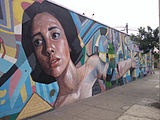
Graffiti in Lima, Peru (2014)

Work of Brazilian artists Os Gêmeos, in Lisbon, Portugal (2011)
Europeedit
London has become one of the most pro-graffiti cities in the world. Although officially condemned and heavily enforced, street art has a huge following and in many ways is embraced by the public, for example, Stik's stick figures. Dulwich Outdoor Gallery, in collaboration with Street Art London, is an outdoor "gallery" of street art in Dulwich, southeast London, with works based on traditional paintings in Dulwich Picture Gallery.
Bristol has a prominent street art scene, due in part to the success of Banksy, with many large and colorful murals dominating areas of the city.
Poland has artists like Sainer and Bezt known for painting huge murals on buildings and walls.
Paris, France has an active street art scene that is home to artists such as Space Invader, Jef Aérosol, SP 38 and Zevs. Some connect the origins of street art in France to Lettrism of the 1940s and Situationist slogans painted on the walls of Paris starting in the late 1950s. Nouveau realists of the 1960s, including Jacques de la Villeglé, Yves Klein and Arman interacted with public spaces but, like pop art, kept the traditional studio-gallery relationship. The 1962 street installation Rideau de Fer (Iron Curtain) by Christo and Jeanne-Claude is cited as an early example of unsanctioned street art. In the 1970s, the site-specific work of Daniel Buren appeared in the Paris subway. Blek le Rat and the Figuration Libre movement became active in the 1980s.citation needed The 13 arrondissement is actively promoting street art through the Street Art 13 project. That includes two remarkable frescos by D*Face from London: "Love will not tear us apart" and "Turncoat". Between October 2014 and March 2015, Fondation EDF hosted Jérôme Catz's exhibition "#STREET ART, L’INNOVATION AU CŒUR D’UN MOUVEMENT", which featured new technologies integrated with pieces by artists including Shepard Fairey, JR, Zevz, and Mark Jenkins. The exhibition became the second most-visited exhibit at EDF since it opened in 1990. Street artist John Hamon's work primarily involves projecting or pasting a poster of his photograph above his name on buildings and monuments across the city.
Street art on the Berlin Wall was continuous during the time Germany was divided, but street art in Berlin continued to thrive even after reunification and is home to street artists such as Thierry Noir Tavar Zawacki a.k.a. ABOVE and SP 38. Post-communism, cheap rents, and ramshackle buildings gave rise to street art in areas such as Mitte, Prenzlauer Berg, Kreuzberg, and Friedrichshain.citation needed In 2016, StreetArtNews initiated an urban artwork in the name of Urban Nation Berlin, in which several famous artists participated.
The second biggest city in Estonia, Tartu, has been called the Estonian street art capital. While Tallinn has been against graffiti, Tartu is known for the street art festival Stencibility and for being home to a wide range of works from various artists.
The street art scene in Greece has been active since the late 1980s but gained momentum in Athens leading up to the country's 2011 financial crisis, with a number of artists raising voices of resistance, creating allegorical works and social commentary in the historic city center and Exarhia district. The New York Times published a story about the crisis in relation to street art and art in general. Street art by Bleepsgr, whose work has been categorized as "artivism", can be found in neighborhoods such as Psiri.
In Spain Madrid and Barcelona represent the most graffiti populated cities, while Valencia, Zaragoza and Málaga also have a street art scene.citation needed
Italy has been very active in street art since the end of the 1990s; some of the most famous street artists include BLU, 108, and Sten Lex.
Street Art in Amsterdam (Netherlands) has a long history. In the mid-1960s, the counterculture movement named the provos already used the street as a canvas. Member Robert Jasper Grootveld wrote things like “Klaas komt” (English: "Klaas is Coming!”) throughout the whole city. At the end of the 1970s, young artists from the punk culture wrote on the decayed city. Well-known artists from this ‘No Future-generation’ are Dr. Rat and Hugo Kaagman, the stencil art pioneer who made his first stencil back in 1978. Yaki Kornblit brought New York graffiti artists like Blade, Dondi, Futura 2000 and Rammellzee to Amsterdam to exhibit in his gallery in the early 80s. This inspired the youth, from which a new generation style writers emerged that was later recorded in the documentary Kroonjuwelen (2006). Names as Delta, Shoe, Jaz, Cat22, High, Again and Rhyme left their mark on the city. In the early 1990s, Amsterdam became the epicenter of the graffiti movement, with a focus on its Metro system, bringing writers such as Mickey, Zedz and Yalt to the capital of the Netherlands. Figurative street art became more and more common in the streets around the turn of the century. Morcky, Wayne Horse, The London Police en Laser 3.14 communicated through their work on the street.
The city of Bergen is looked upon as the street art capital of Norway. British street artist Banksy visited the city in 2000 and inspired many to take their art to the streets. Dolk is among local street artists in Bergen. His art can be seen around the city. Bergen's city council in 2009 chose to preserve one of Dolk's works with protective glass.
In 2011, the city council launched a plan of action for street art from 2011–2015 to ensure that "Bergen will lead the fashion for street art as an expression both in Norway and Scandinavia".
The city of Stavanger is host to the annual NuArt Festival, an event dedicated to promoting street art; the festival is one of the oldest curated "street art" festivals in the world. Nuart Plus is an associated industry and academic symposium dedicated to street art. The event takes place each September. Oslo, by contrast, traditionally has a zero tolerance policy against graffiti and street art, but the sanctioned NuArt RAD project is changing that.
Street art came to Sweden in the 1990s and has since become the most popular way to establish art in public space. The 2007 book "Street Art Stockholm", by Benke Carlsson, documents street art in the country's capital.
The street art scene of Finland had its growth spurt from the 1980s onwards until in 1998 the city of Helsinki began a ten-year zero-tolerance policy which made all forms of street art illegal, punishable with high fines, and enforced through private security contractors. The policy ended in 2008, after which legal walls and art collectives have been established.citation needed
Wheatpaste and stencil graffiti art in Denmark increased rapidly after visits from Faile, Banksy, Ben Eine, and Shepard Fairey between 2002 and 2004, especially in urban areas of Copenhagen such as Nørrebro and Vesterbro. Copenhagen is home of TEJN, the artist credited with introducing the Lock On street art genre.
The street art scene in Switzerland saw the artist Harald Nägeli in the late 1970s. Activity from the nineties on included artists like Toast and NEVERCREW.
Since the collapse of communism in 1989, street art became prevalent in Poland throughout the 1990s. In the city of Łódź a permanent city exhibition was financed in 2011, under the patronage of Mayor Hanna Zdanowska, called "Urban Forms Gallery". The exhibition included work from some of Poland's elite street artists as well as globally known artists. Despite being mostly accepted by the public, with authorities occasionally allowing artists licenses to decorate public places, other properties are still illegally targeted by artists. Warsaw and Gdańsk are other Polish cities with a vibrant street art culture.
A monument in Bulgaria depicting Soviet Army soldiers was targeted by anonymous street artists in June 2011. The soldiers of the monument, located in Sofia, were embellished to portray Ronald McDonald, Santa Claus, Superman, and others. The monument existed in that condition for several days before being cleaned. Some citizens were in favor of allowing the embellishments to remain.citation needed
Moscow has increasingly become a hub for Russian graffiti artists as well as international visitors. The Street Kit Gallery, opened in 2008, is dedicated to street art and organizes events in galleries, pop-up spaces and on the streets of the city. The 2009 Moscow International Biennale for Young Art included a section for street art. Active artists include Make, RUS, and Kiev-based Interesni Kazki (also active in Miami and Los Angeles). Britain's BBC network highlighted the artwork of Moscow street artist Pavel 183 in 2012.
The dissolution of the Soviet Union left Georgia with tantalizing urban space for the development of street art. Although it is a relatively new trend in Georgia, the popularity of street art is growing rapidly. The majority of Georgian street artists are concentrated in Tbilisi. Street art serves as a strong tool among young artists to protest against the many controversial issues in the social and political life in Georgia and thus gets considerable attention in society. Influential artists include Gagosh, TamOonz, and Dr.Love.
Sarajevo has become a major hub for street art in Southeastern Europe. It hosts the Sarajevo Street Art Festival and the acclaimed 3D street art festival, Beton Fest. The former is held in July of every year and lasts for three days. Each year's edition is made up of numerous street performances, the creation of a new street arts bohemian quarter in the city, concerts, the painting of large murals and the showcasing of other creative art forms. The latter is the only 3D street art festival in Southeastern Europe and has hosted many renowned street artists such as Vera Bugatti, Giovanna la Pietra, Tony Cuboliquido, Manuel Bastante and others.

Street art by WATTTS in Paris

Painting in the Global Tradition by Ces53, a Dutch street artist

Street art in Sesimbra, Portugal
Graphic-Domain in Heidelberg by Nicola Pragera
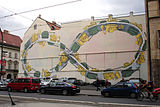
Mural by BLU, Gaza Strip, Prague

Graffiti in Shoreditch, London by Stik
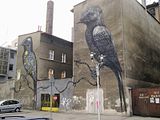
Urban art in Katowice, Poland

Street art in the old city of Prizren, Kosovo

Mural painting "Propagating machine" realized by Nevercrew in Mannheim, Germany in 2017.

Work by Bleepsgr in Athens

Lie Lie Land by female street artist Bambi Graffiti in Islington, London.
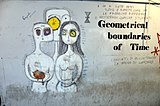
"Geometrical boundaries of Time", street art in Tbilisi.
Asiaedit
South Koreaedit
In South Korea's second-largest city, Busan, German painter Hendrik Beikirch created a mural over 70 metres (230 ft) high, considered Asia's tallest at the time of its creation in August 2012. The monochromatic mural portrays a fisherman. It was organized by Public Delivery.

Street art in Bonifacio Global City, Philippines
United Arab Emiratesedit
In United Arab Emirates' largest city, Dubai, several famous painters created urban mural artwork on the buildings, which was initiated by StreetArtNews and named it Dubai Street Museum.
Indiaedit
In India, street art is hugely popular. Many of the film and TV series promotional materials were created by street painters/artists. Currently, digital art is replacing hand painted posters. From 1960 to the 1990s, the street posters worked well and impressed audiences. In the 1990s the hand painted posters started to be replaced by flex banners outside theatres. After the 2000s, the popularity of street posters started to decline, being replaced by digitally printed posters. Street art painting and street art drawing sketch has since declined in India due to the replacement by digital posters.
Oceaniaedit
Melbourneedit
Melbourne is home to one of the world's most active and diverse street art cultures and is home to pioneers in the stencil medium. Street artists such as Blek le Rat and Banksy often exhibited works on Melbourne's streets in the 2000s (decade). Works are supported and preserved by local councils. Key locations within the city include Brunswick, Carlton, Fitzroy, Northcote, and the city centre including the famous Hosier Lane.
Perthedit
Perth also has a small street art scene.citation needed
Sydneyedit
Sydney's street art scene includes Newtown area graffiti and street art.
New Zealandedit
Dunedin pioneered "official" street art in New Zealand with over sixty bus shelters being given unique murals by painter John Noakes during the 1980s, many of them featuring local scenes or scenes inspired by the names of their locales. The Dunedin City Council has since commissioned a series of similar designs to grace electric boxes around the city. Street murals have also become a popular addition to Dunedin, with over 30 works by both local and overseas artists being added to the central city — especially around the Warehouse Precinct and Exchange areas – since an international street art festival was held there in the early 2000s. These include one of New Zealand's tallest works, a seven-story mural on the wall of the Southern Cross Hotel by Fintan Magee.
Christchurch was devastated by 2 earthquakes in 2010 and 2011 and as a result, 8000 homes and 80 percent of the central city were condemned. It wasn't until two and half years later that the city was able to host its first major cultural eventcitation needed - Rise Street Art Festival held at Canterbury Museum produced by Australasian street art organizer Oi YOU!.
The event attracted over 248,000 visitors (the most-visited show in the Museum's history) and saw 15 murals painted across the devastated central city. The murals became community icons for the re-emergence and rebuild of Christchurch.citation needed
Two further Oi YOU! Festivals, both under the name of Spectrum featured large internal exhibitions as well as adding to the city's stock of murals. Since Rise, over 40 murals have been produced in the central city and the Lonely Planet guide to global street art featured Christchurch as one of the best cities in the world to experience the art form.citation needed
In 2009 in Auckland, street art decorated the city with sophisticated graphic imagery. Auckland's city council permitted electrical boxes to be used as canvases for street art. Local street art group TMD (The Most Dedicated) won the "Write For Gold" international competition in Germany two years in a row. Surplus Bargains is another local collective.
In 2019 in Auckland, a heritage building in the city was painted without the owners' permission by Ares Artifex.
Africaedit
Although street art in South Africa is not as ubiquitous as in European cities, Johannesburg's central Newtown district is a center for street art in the city. The "City Of Gold International Urban Art Festival" was held in the city's Braamfontein civic and student district in April 2012.
The New York Times reported Cairo's emergence as a street art center of the region in 2011. Slogans calling for the overthrow of the Mubarak regime has evolved into æsthetic and politically provocative motifs.
Street art from Egypt, Tunisia, Yemen, and Libya has gained notoriety since the Arab Spring, including a 2012 exhibition in Madrid's Casa Árabe.
















Comments
Post a Comment